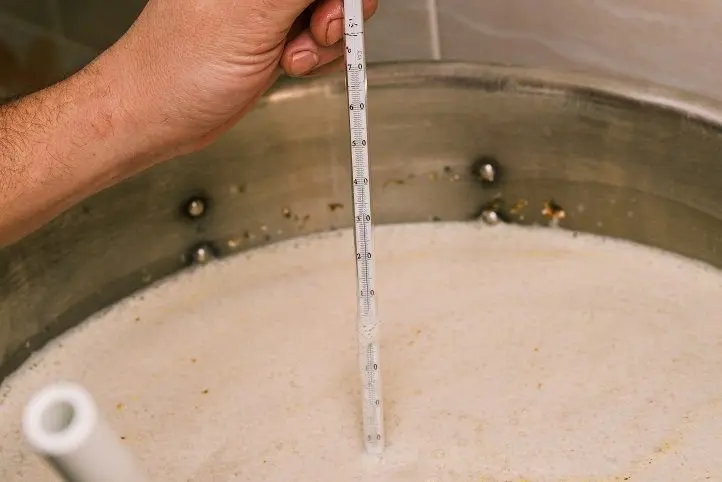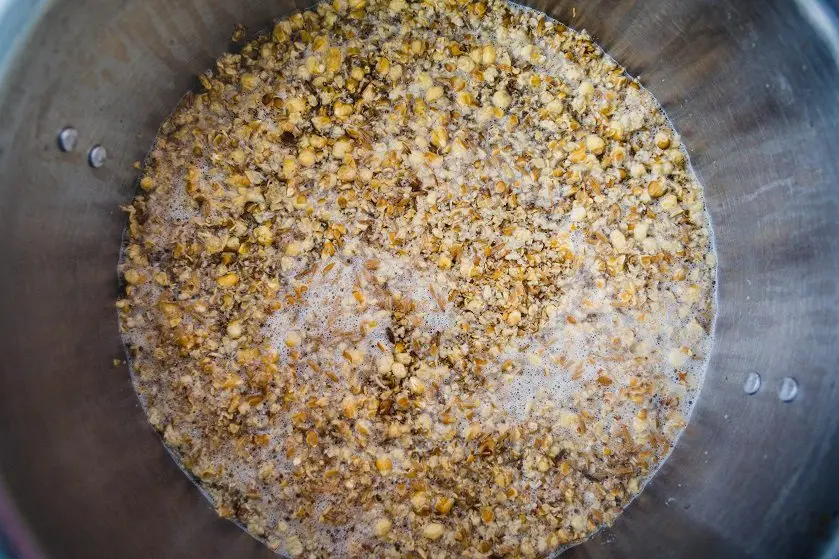Contents
Yeast needs sugar to produce alcohol. In grain crops, it is found in the form of starch, a polysaccharide consisting of chains of glucose, fructose and sucrose molecules. Yeast feeds only on monosaccharides (one molecule), therefore, before laying the mash, the starch molecular chain must be divided into separate molecules, otherwise there will be no fermentation.
Saccharification – this is the process of splitting starch-containing raw materials (flour, cereals, potatoes, etc.) to simple sugars under the influence of natural (from malt) or artificial (synthetic) enzymes. Due to the temperature features of the technology, the first method is called hot saccharification, the second – cold.
In most cases, grain raw materials are cheaper than pure sugar, therefore, even taking into account the lower yield, it is profitable to make mash from cereals, and the taste of grain distillate is much more pleasant than sugar. The theoretical yield of absolute alcohol from different types of crops is presented in the table.
| Raw materials | Alcohol, ml/kg |
|---|---|
| Wheat | 430 |
| Barley | 350 |
| Rye | 360 |
| Corn | 450 |
| Oat | 280 |
| Peas | 240 |
| Millet | 380 |
| rice | 530 |
| beans | 390 |
| Potatoes | 140 |
| Starch | 710 |
| Sugar | 640 |
Attention! These are theoretical values; at home, alcohol losses of up to 15% are possible.
Hot saccharification with malt
A classic method that has been used for centuries. In a humid environment, the grain germinates, which activates the necessary enzymes that can process starch. Grain sprouted to a certain state is called malt, which is of two types: green and white.
Green malt is used for saccharification of raw materials immediately after the appearance of sprouts of optimal length, but is stored for up to 3 days. If the sprouted cereal is dried, a white malt will be obtained, which can be stored much longer. Both types cope with their task with equal efficiency.
The advantage of saccharification with malt is that it takes a few hours to obtain sugar, as a result, the mash will win back faster than with the addition of artificial enzymes.
But this method has a number of disadvantages:
- a high temperature is needed at which the raw material can burn;
- it is required to maintain a stable temperature (60-72 ° C) for several hours, which is sometimes difficult at home;
- saccharified wort is subject to rapid souring.
Malt saccharification technology
1. Grains or flour are slowly poured with water at 50-55 ° C, stirring continuously so that lumps do not form. For 1 kg of raw materials, 4-5 liters of water are required. Fill the container no more than 75%.
2. Raise the temperature to 60°C and hold for 15 minutes.
3. Bring the mixture to a boil. Depending on the raw materials, cook for 60-120 minutes until a homogeneous porridge-like mass is obtained. Flour is cooked less, cereals – longer.
4. Cool the porridge to 63-70°C, add crushed malt (150 grams per 1 kg of raw material), stirring constantly.
5. When reaching 61-65°C, cover the container with a lid and wrap in any way possible to keep warm. Maintain the specified temperature for 2-4 hours. Stir every 50 minutes for the first 30% of the time interval.
6. To prevent the raw materials from sour, lower the temperature to 25 ° C as soon as possible, add yeast (usually 5 grams of dry or 25 grams pressed per 1 kg of raw materials), install a water seal and ferment in a dark place at room temperature. Braga will play in 2-6 days.

If the temperature regime is not observed, saccharification will not occur or will be incomplete, reheating is useless, since the enzymes will lose their activity. The proportions of water, malt and yeast are approximate, exact values and brewing time intervals depend on the recipe and type of raw material.
Cold saccharification with enzymes
Malt can be replaced with two enzymes – Amylosubtilin and Glucavamorin. The first partially breaks down molecules, the second – processes starch into sugar. The technology of cold saccharification is much simpler and cheaper than malt brewing, and the result is approximately the same. Enzymes, along with water, are simply added to the raw materials at the stage of preparing the mash. The conversion of starch to sugar and fermentation occur almost simultaneously.
Benefits of enzyme saccharification:
- easier for novice distillers who do not have special equipment;
- does not require high temperatures and compliance with temperature pauses;
- lower labor costs for the preparation of mash.
Disadvantages:
- requires the presence of special enzymes;
- mash fermentation time increases to 10-20 days;
- there is an opinion that the enzymes of the product are not natural and leave an aftertaste even after several distillations, so in home distillation it is better to stick to the traditional method using malt.
Cold saccharification technology
1. Add raw materials (cereals, flour, starch, pasta, etc.), water 30-35 ° C (3-4 liters per 1 kg of raw materials), Amylosubtilin and Glukavamorin enzymes (3-5 each grams per 1 kg), yeast (5 grams dry or 25 bakery pressed per 1 kg).

The container must not be filled more than 70%, active foaming is possible.
2. Stir, close with a water seal, transfer to a dark place with a temperature of 20-28°C.
3. Fermentation will begin in 1-5 hours, the first couple of days it will be active, then the intensity will decrease. Fermentation time – 7-25 days. If a thin film appears on the surface, this is a sign of souring, the mash needs to be urgently overtaken.
4. Remove the finished mash from the sediment and overtake. Clarification with bentonite is ineffective.
Depending on the recipe, other ingredients may be added to the mash: antibiotics to prevent souring, top dressing of yeast for accelerated fermentation, an acid that stabilizes the acidity of the wort and an antifoam agent. The proportions of Amylosubtilin and Glukavamorin depend on the activity of the enzymes and are indicated on the packaging by the manufacturer.









